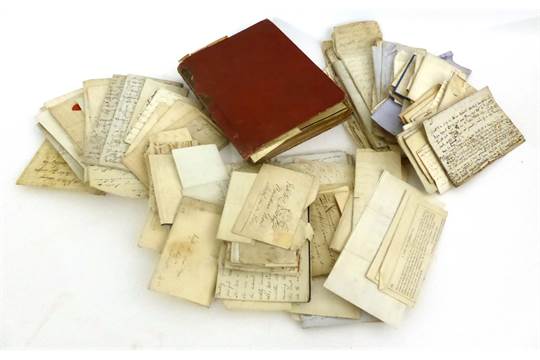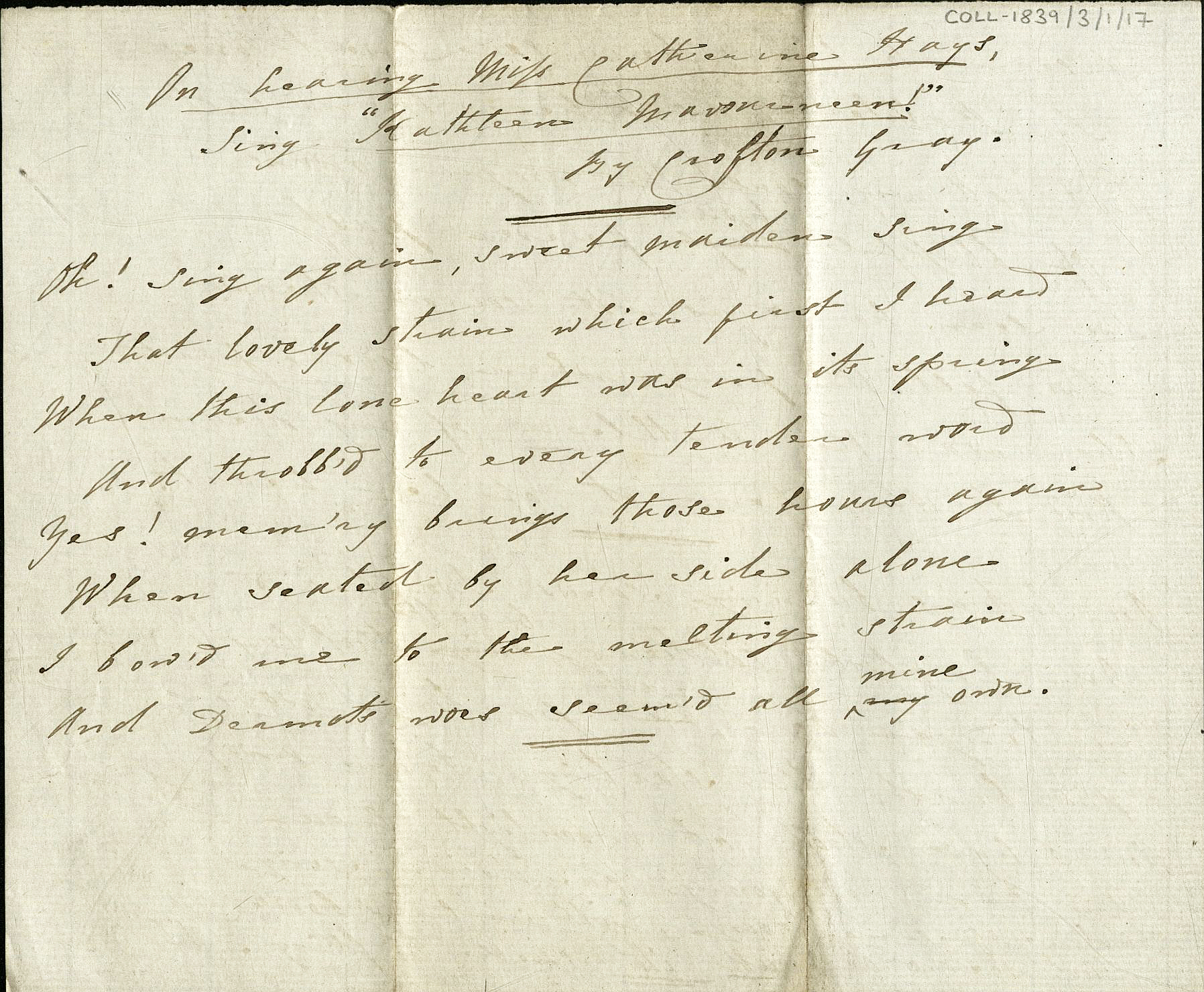Re-discovering a forgotten songwriter: the archive of Louisa Matilda Crawford.
Daisy Stafford, CRC intern who catalogued the papers of Louisa Matilda Crawford, talks about her experience.
This summer I was offered the opportunity to undertake an archiving internship in the Centre for Research Collections, cataloguing the personal papers of Louisa Matilda Crawford, a nineteenth century songwriter. Other than her name and occupation, little information about Louisa was known. Through two months of close examination of her archive, I was able to stitch together a narrative of Louisa’s life. Here’s what I found…
Louisa Matilda Jane Crawford was born on the 27th September 1789 at Lackham House in Wiltshire. She was the daughter of Ann Courtenay (d. 1816) and George Montagu (1753-1815), an English army officer and naturalist. Louisa was related to nobility on both sides of the family; her maternal grandmother, Lady Jane Stuart, was the sister of Scottish nobleman John Stuart, 3rd Earl of Bute and Prime Minister to George III. Her father, meanwhile, was a descendent of Sir Henry Montagu, the first Earl of Manchester and also the great-grandson of Sir Charles Hedges, Queen Anne’s Secretary.

Papers of Louisa Matilda Crawford. Coll-1839 (picture from the seller’s catalogue)
Louisa had three older siblings; George Conway Courtenay (b. 1776), Eleanora Anne (b. 1780) and Frederick Augustus (b. 1783). Little direct information is known about Louisa’s childhood, but it must have been turbulent; in 1798 Montagu left his wife and family and moved to Kingsbridge in Devon to live with his mistress Elizabeth Dorville, with whom he had four more children. It is here that he wrote his two pioneering works, the Ornithological Dictionary; or Alphabetical Synopsis of Birds (1802) and Testacea Britannica, a History of British Marine, Land and Freshwater Shells, which saw several bird and marine species named after him, most notably Montagu’s harrier. The family’s disapproval of his relationship with Dorville ultimately cost him his ancestral home. On the death of his unmarried brother, James, the will stipulated that he would not inherit Lackham House, but had only “a rent charge of £800 a year subject to which the estates were left to his eldest son, George, for life.” The ensuing lawsuit between the pair resulted in huge debts which cost the family the estate; as Louisa wrote in The Metropolitan Magazine in 1835; “The thoughtless extravagance of youth, and the unwise conduct of mature age, caused the estates to be thrown into chancery” (vol. 14, pp. 308-309). Louisa reflected on seeing the native woods of her family home cut down upon its sale in a later poem (Coll-1839/7 pp.415-416):
Those brave old woods, when I saw them fall,
Where they stood in their pride so long,
The giant guards of our ancient hall,
And the theme of our household song;
I wept, that one of my Father’s race
Could forget the name he bore,
And turn the land to a desert place,
Where an Eden bloom’d before.
Louisa began courting Matthew Crawford, a barrister of Middle Temple, in 1817. Many of the papers consist of love letters and poems exchanged between the pair during this early period of their relationship, including three locks of hair, presumably Louisa’s. In 1822 the couple were married and Louisa moved to London, although their continued correspondence evidences that Matthew spent much of their marriage away working in the North of the country. It is then that Louisa began to earn an income through song writing and poetry, although the couple always struggled financially and frequently appealed to their wealthier relatives for aid.
Much of Louisa’s work appeared, often anonymously, in magazines and journals, was sold to publishers, and was set to music by composers Samuel Wesley, Sidney Nelson, Edward Clare and others. She frequently contributed both poems and prose, including several “autobiographical sketches”, to London literary journal The Metropolitan Magazine (which has subsequently been digitised by the HathiTrust and can be fully searched here). Many of her songs and poems related to historical events and persons; songs titled “Anne Boleyn’s Lamentation” (Coll-1839/7 p. 285) or “Chatelar to Mary Queen of Scots” (Coll-1839/7 pp. 381-382) are written from the point of view of famous queens. One poem (Coll-1839/3/1/9) tells the story of Frederick the Great (1712-1786), King of Prussia, who, in order to deceive his enemies as to his position during the Seven Years’ War, commanded that no light should be kindled throughout his encampment. However, a young soldier lit a taper to write a letter to his new bride. The second stanza reads:
His head was bent in act to write,
The memories gusting o’er him –
When through the gloom of gathering night,
Stood Frederick’s self before him!
Oh sternly spoke the Monarch then
His doom of bitter sorrow
“Resume the seat – Resume the pen
And add “I die tomorrow.”
Other poems in the collection are more personal, including reflections on her childhood and family, such as “The Home of Our Childhood” (Coll-1839/7 pp. 17-18) and “On the Death of a Sister” (Coll-1839/7 p. 394). Many verses are addressed to her husband Matthew; one poem (Coll-1839/1/2/5) dated 23rd July 1817 and titled “To Him I Love”, begins:
Oh! Doubt not the faith of a heart which is thine
Nor cast on its feelings a thought thats unkind
For believe me thine image whilest life shall be mine
Cannot fail to be cherish’d and dear to my mind
Like a miser I hoard in my hearts hidden core
Every look every word that from thee I receive
And never ah! never till lifes dream is o’er
Will the love which I bear thee be alter’d believe

Coll-1839/1/2/5. Poem addressed to Matthew Crawford titled “To Him I Love” in the hand of Louisa Matilda Crawford, 23 July 1817.
Matthew often responded with poems of his own, and seems to have played a collaborative role in Louisa’s writing. She frequently included stanzas of her work in letters to him, asking him to look over and edit them.

Louisa’s most successful song, “Kathleen Mavourneen,” was set to music by composer Frederick Crouch and enjoyed wide success in America where it was popularised by Irish Soprano Catherine Hayes on her international tours. Recordings of it still exist, and a version by Irish tenor John McCormack (1884-1945) can be found on youtube here. No original version of the song is amongst her papers, although there is a poem titled “On hearing Miss Catherine Hays [sic] sing “Kathleen Mavourneen!”” (Coll-1839/3/1/17). However, the song was frequently attributed solely to Crouch, or erroneously to Annie, Julia, or Marion Crawford.

Coll-1839/3/1/17. Poem titled “On hearing Miss Catherine Hays, sing “Kathleen Mavourneen!” by Crofton Gray” in the hand of Louisa Matilda Crawford, 1837-1857.
Louisa arranged her poems into small series, and the collection includes ten stitched booklets with titles such as “Irish ballads” and “Scotch songs”. Attempts to track down her work can be seen in correspondence with her publishers. In an undated later to magazine editor Mr Emery (Coll-1839/1/1/22) she requests copies of her published songs, writing; “I am not wanting them to give away, but to have them bound up in a volume since I find it impossible to keep single songs…I am going to beat up for recruits in all quarters where my bagatelles have been published, in order that I may have a little memorial to leave to those that will value the gift when I am gone.” A notebook containing 165 poems and songs neatly written in Louisa’s hand seems to be the result of these efforts.
Some outlying items in the collection initially seemed not to relate to Louisa at all, including a 17th century indenture on vellum, recording the sale of a messuage or house between waterman Thomas W Watson and master mariner Josiah Ripley of Stockton-on-Tees. However, a bit of biographical research revealed the answer. Many of these miscellaneous items reference Bayley and Newby, a firm of solicitors operating out of Stockton-on-Tees in the 19th century, which may explain the presence of the indenture. Matthew Crawford’s first cousin, William Crawford Newby (1807-1884) worked at the firm, and it seems that, since the couple were childless, their papers passed to him upon their deaths and thence on to his heirs. The latest item in the collection (Coll-1839/1/3/16) is a 1930 letter by William’s son, who writes:
I enclose a manuscript book written by Mrs Crawford including many well-known songs…Mrs Crawford was a Montagu of the Duke of Manchester family and died in 1857. She was married to Matthew Crawford a barrister. They had independent means which however they frittered away. My late father who was a 1st cousin of Matthew Crawford’s assisted them from time to time and their M.S.S. came to him on their death and through him to me. I am not anxious to part with them, but I am an old man and my family may not attach the same importance to their possession.
This would seem to account for how the papers came to be in the possession of the bookseller and for the few items relating to the Newby’s present in the collection.
Louisa died in 1857, the cause unknown, although Matthew refers to a long affliction of heart disease supplemented by attacks of Bronchitis in an 1846 letter (Coll-1839/2/6). Despite her obvious talent, and the clear enjoyment she derived from her work, she received little notoriety for her song writing during her lifetime and even less so after her death. Alongside gaining invaluable archival skills during this project it has been a pleasure to think that I have been able to increase the visibility of Louisa’s work and make her collection available to interested researchers. Although separated by over two centuries, I have come to know more about Louisa than any person living, and that is a great privilege.
You can see the catalogue of the papers on ArchivesSpace: https://archives.collections.ed.ac.uk/repositories/2/resources/86789
References:
Cleevely, R. J. “Montagu, George.” Oxford Dictionary of National Biography Online, 23 Sep. 2004, https://doi.org/10.1093/ref:odnb/19017. Accessed 19 Jul. 2018.
Crawford, Louisa Matilda Jane. The Metropolitan Magazine. Accessed 19 Jul. 2018.
- “An Auto-Biographical Sketch. Lacock Abbey.” Vol. 12, Jan-Apr. 1835, pp. 400-402, https://babel.hathitrust.org/cgi/pt?id=nyp.33433081737904;view=1up;seq=412.
- “Autobiographical Sketches Connected with Laycock Abbey.” 14, Sept-Dec. 1835, pp. 306-318, https://babel.hathitrust.org/cgi/pt?id=nyp.33433081737888;view=1up;seq=322.
- “Autobiographical Sketches.” Vol. 22, 1838, pp. 310-317, https://babel.hathitrust.org/cgi/pt?id=umn.319510007530342;view=1up;seq=325.
- “Autobiographical Sketches.” Vol. 23, Sept-Dec. 1838, pp. 189-194, https://babel.hathitrust.org/cgi/pt?id=nyp.33433081737839;view=1up;seq=203.
Cummings, Bruce F. “A biographical sketch of Col. George Montagu (1755-1815).” Zoologisches Annalen Würzburg, vol. 5, 1913, pp. 307–325, http://www.zobodat.at/pdf/Zoologische-Annalen_5_0307-0325.pdf. Accessed 19 Jul. 2018.
“Kathleen Mavourneen.” Wikipedia, https://en.wikipedia.org/wiki/Kathleen_Mavourneen. Accessed 19 Jul. 2018.
Pratt, Tony. Two Georgian Montagus: the manor of Lackham. Wiltshire College, second edition, 2015, https://tinyurl.com/y7tpp39h. Accessed 19 Jul. 2018.
Urban, Sylvanus. “Obituary – Rev. George Newby.” The Gentleman’s Magazine, vol. 26, 1846, pp. 100-101, https://tinyurl.com/yatonw6n. Accessed 19 Jul. 2018.
Written by Daisy Stafford, July 2018.